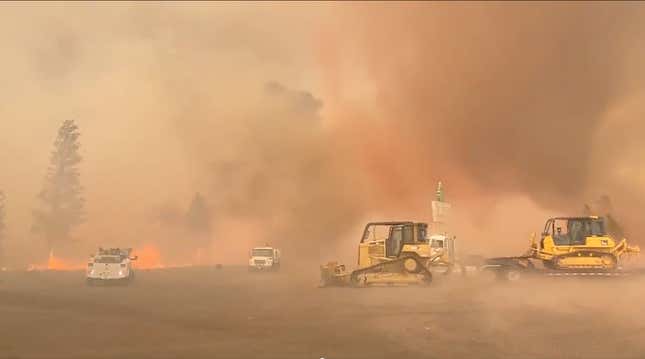
As brutal heat continues to scorch the West, it is sparking wildfires that are burning through hundreds of thousands of acres of land. In California, this year’s wildfires are outpacing the damage caused by last year’s record-setting fire season.
One blaze in California sparked a firenado over the weekend—the state’s second in three weeks. It’s indicative of the severity of the fires burning in the state, and spreading across the West in general. With more heat and single-digit humidity on tap for the start of the week, there could unfortunately be more extreme fire behavior.
Firenadoes Are Our Latest Horror
The Beckwourth Complex, made up of two lightning-caused fires on the east edge of the Plumas National Forest, north of Lake Tahoe, doubled in size late last week and became the state’s largest fire of 2021 at nearly 90,000 acres as of Monday morning. On Saturday, the flames also whipped up a firenado. Firefighters captured terrifying footage of the occurrence.
“Fucking tornado,” a firefighter can be heard yelling in a video posted to Instagram as people scramble for cover inside vehicles while smoke and debris whip around. Watch the videos if you want to believe that hell is a place on Earth.
Firenadoes are also known as fire tornadoes, fire twisters, or perhaps most accurately, fire devils. (They’re also sometimes called fire whirls, though some meteorologists draw a distinction for that term for smaller but still terrifying fire weather occurrences.) They occur when large wildfires superheat the air. That causes the air to rise. As it rises, it cools and condenses in the upper reaches of the atmosphere, creating unstable conditions and a clash of air that can causes firenadoes to form. Researchers are still studying exactly what conditions lead to firenadoes, but they are among the world’s rarest extreme weather phenomena.
Yet other footage also released in the past week by the Forest Service shows that this was not California’s first firenado of the year. The video, shot on June 29, shows a powerful twister in the Tennant fire in Klamath National Forest near the state’s border with Oregon.
Wildfires Are Burning Across the West
The West’s blazes are hardly confined to California. In fact, the largest wildfire in the region is currently Oregon’s Bootleg Fire. That blaze has been burning for six days straight. As of Monday morning, the inferno has scorched more than 150,000 acres.
On Friday, California Gov. Gavin Newsom dispatched firefighting teams from the Bay Area to Oregon to help with containment. But the hot, windy conditions in the state escalated on Saturday, forcing firefighters to “disengage and move to predetermined safety zones” to avoid “immediate, life-threatening risk” from the Bootleg fire, officials said in a statement. With the flames threatening 3,000 houses, residents in nearby areas were forced to evacuate, and the danger was so severe that the Klamath County sheriff’s department began issuing citations for people who refused to follow evacuation orders.
Flames and Heat Have Put Electrical Infrastructure At Risk
The Bootleg Fire also disrupted electricity lines that transmit power from Oregon to California, known as California Oregon Intertie or Path 66. The lines are owned by PG&E, PacifiCorp, the Western Area Power Administration, and the Transmission Agency of Northern California.
On Saturday, the California Independent System Operator told reporters that the Bootleg Fire took the corridor offline, leaving the state with 5,500 fewer megawatts of available power amid a blistering heat wave. Newsom signed orders on Friday and Saturday to allow the state to use backup generators and auxiliary ship engines to help offset the strain on the grid. After officials urged residents to reduce their power consumption, Californians conserved enough electricity to weather the high energy demand and avoid widespread blackouts. A flex alert is in place for Monday, meaning the state isn’t out of the power outage woods yet.
It’s not just California and Oregon that are suffering due to wildfires sparked by extreme heat. As of Monday morning, wildfires were burning across more than 768,000 acres in 12 states. In Arizona on Saturday, two firefighters who were working with the Bureau of Land Management to surveil the Cedar Basin Fire in northwest Arizona perished when their plane crashed. Fires are also spreading across western Canada, causing officials to prepare themselves to “take emergency measures.”
Climate scientists have warned for decades that the world would see hotter temperatures, worse heat waves, and terrifying forest fires without transformative, urgent action to stop using fossil fuels and curb greenhouse gas emissions to tackle the climate crisis. The wildfires are the latest sign that the climate crisis isn’t some far-off future concern. It’s happening right here, right now.